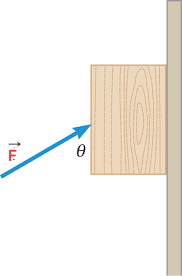
Let the force #vecF# be applied on the block obliquely at an angle of #theta=60^@# with the vertical as shown in the figure above.
The resolved part of the applied force #vecF# perpendicular to the wall will be #vecFsintheta# and the resolved part parallel to the wall in upward direction is #vecFcostheta#
So static fictional force in upward direction is
#F_suarr="coefficient of friction"(mu_s)xxFsintheta#
#=0.9vecFsintheta#
So considering the equilibrium of forces we have
#vecFcostheta+0.9*vecFsintheta=mg#
#=>vecFcos60+0.9*vecFsin60=2*10#
#=>vecF=20/(1/2+(0.9sqrt3)/2)~~15.6N#
If the applied force #vecF# acts obliquely downward making an angle #theta=60^@# with the vertical then the component of #vecF# in vertical direction will be downward and equilibrium of force will give the following relation.
#0.9*vecFsintheta=mg+ vecFcostheta#
#=>-vecFcos60+0.9*vecFsin60=2*10#
#=>vecF=20/(-1/2+(0.9sqrt3)/2)~~71.6N#


